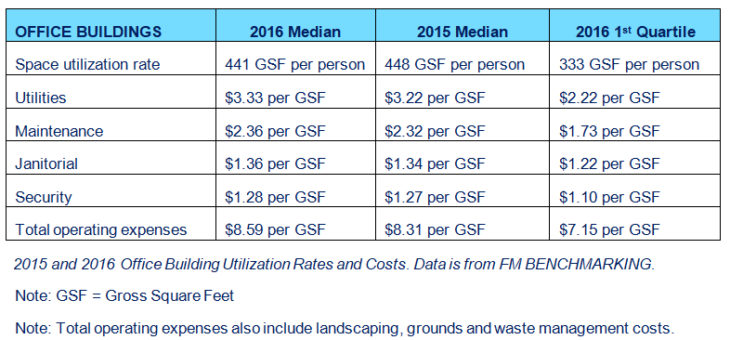FM BENCHMARKING: Office Building Operating Costs Rose Slightly in 2016

 FM BENCHMARKING, the largest global online benchmarking tool for facilities managers and corporate real estate professionals, announced its annual changes in building operating expenses. Data compares metrics from 2015 to 2016, and is summarized in the chart above.
FM BENCHMARKING, the largest global online benchmarking tool for facilities managers and corporate real estate professionals, announced its annual changes in building operating expenses. Data compares metrics from 2015 to 2016, and is summarized in the chart above.
Overall, for office facilities, taking into account utility, maintenance, janitorial, security, grounds and paving costs, there was a 3.4% increase from 2015 to 2016. The first quartile number was 17% below the median.
Space utilization rates dropped slightly (1.6%) for office space, as companies are trying to fit more people into the same amount of space.
Utility costs had the largest year-to-year increase (3.4%) in office buildings. It also had the largest difference (33%) between the first and second quartile numbers: the top 25% spent $2.22 per gross square foot, while the median company spent $3.33.
Maintenance costs had a 1.7% year-to-year increase, with the first quartile costs 25% below the median. Janitorial costs had a 1.5% year-to-year increase; the first-to-second quartile difference was only 10%. Security costs had just a 0.8% increase from 2015 to 2016.
The smaller difference between the first quartile and median performance for the maintenance, janitorial and security areas compared to that for utilities is a combination of two factors: (a) there is more that companies can do to bring utility costs down than other facility costs, and (b) there is more variation between companies in their utility needs.
The numbers for manufacturing companies were similar, but with slightly smaller increases. Utility costs went up 2.7% (instead of 3.4%), and maintenance costs went up just 0.8% (versus 1.7%). Janitorial and security costs remained the same.
“More people are benchmarking their facilities each year, as they discover the potential savings possible as a result,” according Peter Kimmel, one of FM BENCHMARKING’s Principals. “We didn’t see as much difference in the general data between 2015 and 2016 as we have in the past, but some of the numbers vary quite a bit depending on which filters are being applied,” he continued. “For example, items such as climate, hours of building operation, and maintenance and janitorial quality standards are among filters that can shift the numbers significantly.”
The statistics are based on data input by more than 2,000 global facilities (about 70% are in the U.S.), as reported by facilities managers and other corporate real estate professionals. The system automatically converts building metrics and currencies to the units of choice for users.
The typical company using the methodology has experienced a 31% reduction in operating costs and a 40% decrease in energy consumption over a ten-year period.
FM BENCHMARKING offers its facility benchmarking services to compare metrics for the following: space utilization, utilities, maintenance, janitorial, security, landscaping and grounds, and waste management.
FM BENCHMARKING enables its clients to input their own building data and then compare it to those of other similar buildings; it then shows its clients which best practices are being employed in those buildings outperforming its clients’ buildings. It also offers a Query Edition that enables clients to run comparison reports without inputting any data. Each client can apply a comprehensive set of filters to ensure they are making valid comparisons with each report.
For more information, see the FM BENCHMARKING Web site (www.fmbenchmarking.com).





